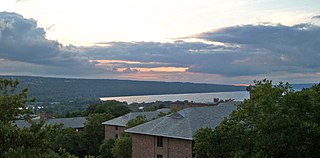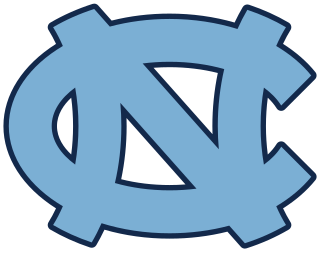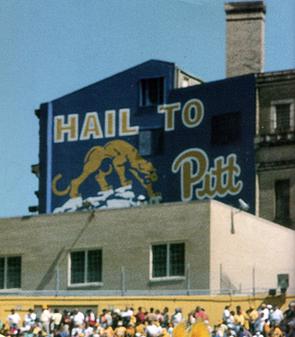
"Far Above Cayuga's Waters" is Cornell University's alma mater. The lyrics were written circa 1870 by roommates Archibald Croswell Weeks, and Wilmot Moses Smith, and set to the tune of "Annie Lisle", a popular 1857 ballad by H. S. Thompson about a heroine dying of tuberculosis.

Woody Lombardi Durham was an American play-by-play radio announcer for the North Carolina Tar Heels football and men’s basketball programs from 1971 to 2011.

"Carmen Ohio" is the oldest school song still used by Ohio State University. The song was composed by freshman athlete and Men's Glee Club member Fred Cornell in 1902 or 1903. According to some accounts, he composed it on the train ride home from Ann Arbor, Michigan after Ohio State suffered an 86-0 loss to the Michigan Wolverines. The song was set to the tune of "Spanish Hymn", or "Spanish Chant", and the Men's Glee Club first performed it in 1903; however, it did not gain popularity until after its publication in The Lantern on October 10, 1906. At the following Ohio State-Michigan football game on October 20, 1906, "Carmen Ohio" was published in the program. In 1915, Cornell recalled that he wrote the song in 1903 at the request of the Men's Glee Club, and other family members later stated that the train story might be an exaggeration or outright fabrication. Currently, after every home football game in Ohio Stadium, win or lose, the football team and the crowd sing the first verse of Carmen Ohio, accompanied by The Ohio State University Marching Band. It is also sung by new graduates at the end of the university's commencement ceremonies, after diplomas are distributed.

"On the Banks of the Old Raritan" is a song, or alma mater, associated with Rutgers, The State University of New Jersey, in the United States. The original lyrics were written in 1873 by Howard Newton Fuller, an 1874 graduate of Rutgers College. Fuller quickly prepared the song as a school hymn for the college's Glee Club, an all-male choral ensemble, before a performance in Metuchen, New Jersey. Fuller chose to set the lyrics to the tune of melody, "On the Banks of the Old Dundee", a popular Scottish melody regarded as a drinking song, and titled the song for the Raritan River.

The North Carolina Tar Heels are the intercollegiate athletic teams that represent the University of North Carolina at Chapel Hill. The name Tar Heel is a nickname used to refer to individuals from the state of North Carolina, the Tar Heel State. The campus at Chapel Hill is referred to as the University of North Carolina for the purposes of the National Collegiate Athletic Association. The University of North Carolina at Chapel Hill was chartered in 1789, and in 1795 it became the first state-supported university in the United States. Since the school fostered the oldest collegiate team in the Carolinas, the school took on the nickname Carolina, especially in athletics. The Tar Heels are also referred to as UNC or The Heels.

The North Carolina Tar Heels football team represents the University of North Carolina at Chapel Hill in the sport of American football or Gridiron Football. The Tar Heels play in the Football Bowl Subdivision (FBS) of the National Collegiate Athletic Association (NCAA) and the Coastal Division of the Atlantic Coast Conference (ACC).

The "Penn State Alma Mater" is the official alma mater of The Pennsylvania State University. The song was accepted by the university in 1901.
Mike Fox is an American retired college baseball coach. Fox was the North Carolina head baseball coach for 22 seasons and is considered one of the school's most successful coaches, having led the Tar Heels to seven College World Series appearances, including four consecutive from 2006 to 2009. Over his 37-year head coaching career, he compiled a 1,487–547–5 record. Fox was named to the North Carolina Sports Hall of Fame in 2017.
"Roar, Lion, Roar" is the primary fight song of Columbia University. It was originally titled "Bold Buccaneers" and was written with different lyrics for the 1923 Varsity Show Half Moon Inn by Columbia undergraduates Corey Ford and Morris W. Watkins, and alumnus Roy Webb. In order to compete in the Columbia Alumni Federation's contest to find a school fight song the same year, Ford wrote a new set of lyrics that would become "Roar, Lion, Roar". The title references Columbia's mascot, the Columbia Lion.
"The Good Old Song" is the de facto school song of the University of Virginia. It is often said to be the university's fight song, although the actual fight song is "The Cavalier Song". It is set to the music of "Auld Lang Syne", a song frequently sung on New Year's Eve.

"Hail to Pitt" is the most traditional fight song of the University of Pittsburgh, which is commonly referred to as Pitt. The saying "Hail to Pitt!" is also the most traditional and commonly used slogan of the University of Pittsburgh and its athletics teams. The slogan is frequently used in promotional material, printed on merchandise and souvenirs. It was also the title of a 1982 history of Pitt athletics by author Jim O'Brien. The slogan is often used among alumni as a statement of affiliation, including as a closing signature in conversation or correspondence between alumni, and is sometime abbreviated as "HTP" or "H2P", the latter of which is a registered trademark of the university and is frequently used on official university signage and merchandise.

The alma mater of the University of Pittsburgh was adopted soon after the University changed its name in 1908 from the Western University of Pennsylvania to its current moniker. Lyrics were written by George M. P. Baird, class of 1909 and were set to the tune of what was then the Austrian National Anthem. A new tune for the "Alma Mater" hymn was composed by Charles W. Scovel, class of 1883, but it was not widely adopted and was either lost or became obscure.

The Syracuse University Alma Mater is the school song for Syracuse University. It was written by Junius W. Stevens in 1893, and is based on the then-popular Irish melody Annie Lisle. It was first sung under the title "Song of Syracuse" by the University Glee and Banjo Club on March 15, 1893 at the Wieting Opera House.
"Our Alma Mater" is the alma mater of The College of William & Mary. It was written by James Southall Wilson, a William & Mary alumnus from the class of 1904. Usually, only the first and fourth verses are sung. The song is set to the tune of Annie Lisle, which is used in the alma mater songs of many other colleges, most notably Cornell University.

The Marching Tar Heels is the athletics pep band for the University of North Carolina at Chapel Hill. Known as "The Pride of the ACC", the Marching Tar Heels is one of the largest organizations at UNC with over 290 students. The band plays at all home football games as well as travels to away games, usually as a small pep band. However, the entire band travels to one away football game each year, usually staying close to home. These have included trips to universities such as NC State and East Carolina but have also included some longer trips to venues such as Notre Dame in 2006 and the Chick-fil-A Kickoff Game in 2010 and 2016.
William Starr Myers was a Princeton University professor and historian who chronicled New Jersey and the GOP

"Hail to the Orange" is the alma mater of the University of Illinois at Urbana–Champaign. Its alternate version, "Hail to the Purple," is an official song of the fraternity Sigma Alpha Epsilon. The song was written in 1910 by two students: Harold Vater Hill, credited with the music, and Howard Ruggles Green, credited with the lyrics.

James Christopher MacRae was a college football player and coach as well as an attorney. He was once mayor of Chapel Hill, North Carolina.

Joseph Daniel Talbott was an American professional football and baseball player. At the University of North Carolina at Chapel Hill, he was a quarterback for two seasons with the North Carolina Tar Heels football team and was named the ACC Player of the Year in 1966. Talbott also led the Tar Heels baseball team to the College World Series in 1966. He also played basketball for North Carolina on their freshmen team, but gave up the sport to concentrate on football and baseball. He was drafted in the 17th round of the 1967 NFL Draft by the San Francisco 49ers, but did not sign a contract with the team and played baseball professionally in the Baltimore Orioles's minor league system instead. His NFL draft rights were traded to the Washington Redskins for a 10th round draft pick on March 5, 1968, but during training camp he was called into active service duty for the United States Army Reserve and missed the entire season. He spent the 1969 season on the Redskins' taxi squad, and was released during final roster cuts before the start of the 1970 season on August 10, 1970.
"Stand, Columbia" is the official alma mater of Columbia University in New York City, New York. It was written in Gilbert Oakley Ward for the university's 1902 Class Day ceremonies, and is sung to the tune of Joseph Haydn's "Gott erhalte Franz den Kaiser", which served as the melody for the Austrian national anthem until 1938, and was adopted as the German national anthem in 1922. The hymn is traditionally played at the university's baccalaureate services and commencements.













